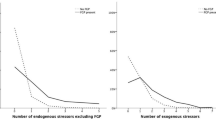Abstract
Family environments of married male members of Gamblers Anonymous (GA) and married female members of GamAnon were measured with the Family Environment Scale (FES), a measure of 10 characteristics of family life. The total sample of 86 included 50 male GA and 36 female GamAnon members. GA and GamAnon groups did not differ from each other. However, the short-term GA group reported greater dissatisfaction than controls on five personal growth dimensions. The long-term GA group reported less Conflict than controls. Both short-term and long-term GamAnon groups reported less satisfaction than normal controls on personal growth dimensions. A composite measure of social support demonstrated improvement with duration of abstinence for gamblers but not for spouses. Results suggest improvement in family environment for male pathological gamblers with length of gambling abstinence but less improvement for wives.
Similar content being viewed by others
References
Ahrons, S. (1989).A comparison of the family environments and psychological distress of married pathological gamblers, alcoholics, psychiatric patients and their spouses with normal controls. Unpublished doctoral dissertation. University of Maryland, College Park.
Bandura, A. (1986).Social foundations of thought and action: A social cognitive theory. Englewood Cliffs, NJ: Prentice-Hall.
Barlow, D.H. (1988).Anxiety and its disorders: The nature and treatment of anxiety and panic. New York: Guilford.
Billings, A.G., & Moos, R.H. (1985). Life Stressors and social resources affect posttreatment outcomes among depressed patients.Journal of Abnormal Psychology, 94, 140–153.
Boyd, W., & Bolen, D.W. (1970). The compulsive gambler and spouse in group psychotherapy.International Journal of Group Psychotherapy, 20, 77–90.
Brown, R.I.F. (1986). Dropouts and continuers in Gamblers Anonymous: Life-context and other factors.Journal of Gambling Behavior, 2, 130–140.
Ciarrocchi, J.W. (1993). Pathological gambling and pastoral counseling. In R.J. Wicks, R.D. Parsons & D.E. Capps (Eds.),Clinical handbook of Pastoral Counseling. Volume 2. New York: Paulist Press.
Ciarrocchi, J., & Hohmann, A.A. (1989). The family environment of married male pathological gamblers, alcoholics, and dually addicted gamblers.Journal of Gambling Behavior, 5, 283–291.
Darvas, S. (October, 1981).The spouse in treatment: Or, there is a woman (or women) behind every pathological gambler. Paper presented at the Fifth Annual National Conference on Gambling and Risk-Taking, Reno, NV.
Holahan, C.H., & Moos, R.H. (1981). Social support and psychological distress: A longitudinal analysis.Journal of Abnormal Psychology, 90, 365–370.
Kurtz, E. (1979).Not-God: A history of Alcoholics Anonymous. Center City, MN: Hazelden Educational Services.
Lesieur, H. (1984).The chase. Cambridge, MA: Schenkman Books.
Lesieur, H.R., & Rothschild, J. (1989). Children of Gamblers Anonymous members.Journal of Gambling Behavior, 5, 269–282.
Lorenz, V.C., & Yaffee, R.A. (1986). Pathological gambling: Psychosomatic, emotional and marital difficulties as reported by the gambler.Journal of Gambling Behavior, 2, 40–49.
Lorenz, V.C., & Yaffee, R.A. (1988). Pathological gambling: Psychosomatic, emotional and marital difficulties as reported by the spouse.Journal of Gambling Behavior, 4, 13–26.
Lorenz, V.C., & Yaffee, R.A. (1989). Pathological gamblers and their spouses: Problems in interaction.Journal of Gambling Behavior, 5, 113–126.
McCormick, A., & Brown, R.I.F. (1988). Gamblers Anonymous as medicine, as religion and as addiction recovery process. In W.R. Eadington (Ed.),Gambling research: Proceedings of the Seventh International Conference on Gambling and Risk Taking (pp. 344–364). Reno, NV: University of Nevada-Reno.
Moos, R.H., & Moos, B.S. (1981).Family Environment Scale manual. Palo Alto, CA: Consulting Psychologists Press.
Moos, R.H., & Moos, B.S. (1984). The process of recovery from alcoholism: III. Comparing functioning in families of alcoholics and matched control families.Journal of Studies on Alcohol, 45, 111–118.
Tepperman, J.H. (1985). The effectiveness of short-term group therapy upon the pathological gambler and wife.Journal of Gambling Behavior, 1, 119–130.
Wildman II, R.W. (1989). Pathological gambling: Marital-familial factors, implications and treatment.Journal of Gambling Behavior, 3, 37–40.
Author information
Authors and Affiliations
Additional information
The authors wish to thank Mr. Les Franklin for assistance with data coding.
Rights and permissions
About this article
Cite this article
Ciarrocchi, J.W., Reinert, D.F. Family environment and length of recovery for married male members of Gamblers Anonymous and female members of GamAnon. J Gambling Stud 9, 341–352 (1993). https://doi.org/10.1007/BF01014626
Issue Date:
DOI: https://doi.org/10.1007/BF01014626



